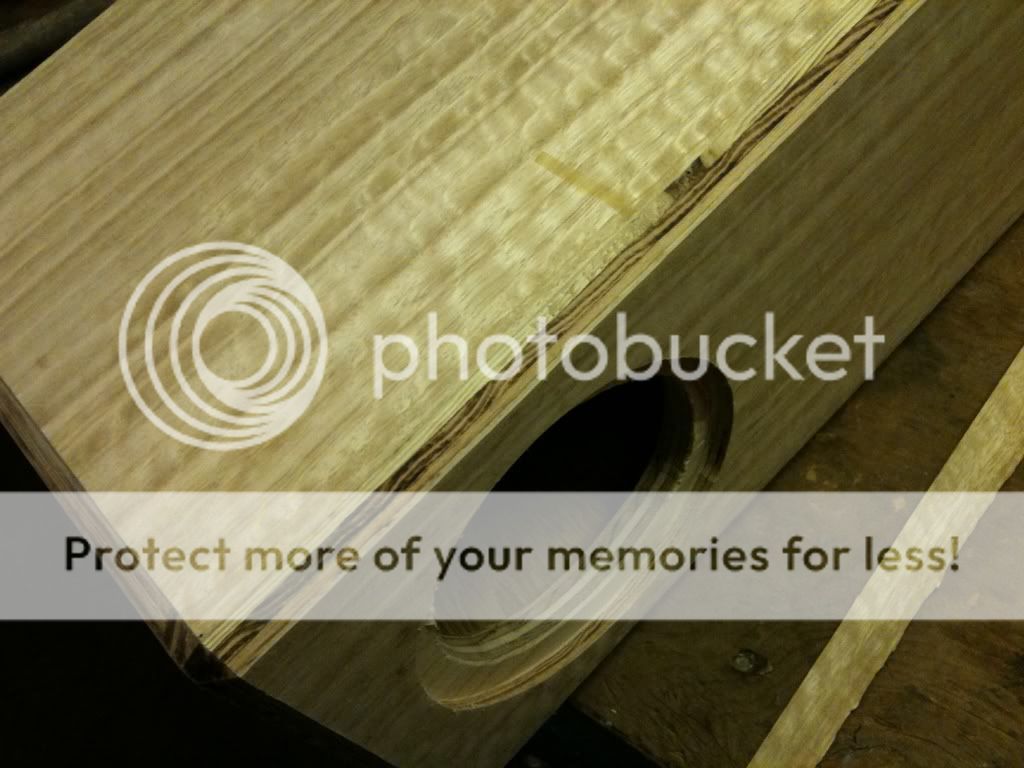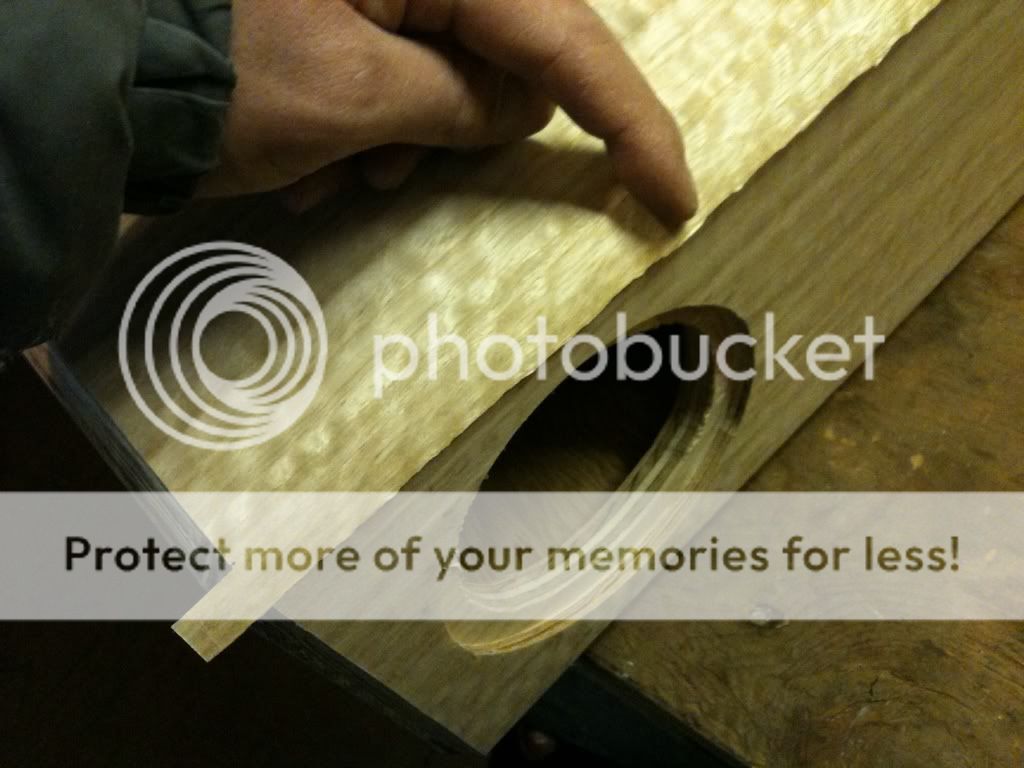Hi,
Building a little desktop speaker. I chamfered the edges and thought, man that looks good just like that. So I asked a friend and my wife and they both thought it looked better. But no woodworker would actually do this, so I have to ask, will this look dumb if I don't veneer the chamfer. I'd finish it the same as the rest of the veneer. Not sure what that'll be yet, perhaps some suggestions of finishes for figured eucalyptus would be appreciated
A
B
A

B

Building a little desktop speaker. I chamfered the edges and thought, man that looks good just like that. So I asked a friend and my wife and they both thought it looked better. But no woodworker would actually do this, so I have to ask, will this look dumb if I don't veneer the chamfer. I'd finish it the same as the rest of the veneer. Not sure what that'll be yet, perhaps some suggestions of finishes for figured eucalyptus would be appreciated
A
An externally hosted image should be here but it was not working when we last tested it.
B
An externally hosted image should be here but it was not working when we last tested it.
A

B

I like the look of plywood edges and use it to my advantage in a lot of designs; not just speakers. I'm not the only one. I keep seeing Baltic birch(BB) ply with exposed and finished edges in a lot of installations at boutiques, bars and restaurants. But, most importantly, if it looks good to you then it /is/ good. I will try to dig up a picture of a display cabinet I built from BB, I beveled parts of the vertical edges to add a little drama and finished each bevel in a lamb's tongue. The bevels got a lot of nods.
I think exposed ply edged are fine as long as the ply is the high quality stuff with many thin plies and witout voids or irregularities. One option to consider might be veneering the chamfers (at least the front and top ones) in a contrasting wood like walnut. That would highlight the chamfers without being as visually busy as the exposed edge of the plies. A method that might work (if the width of the chamfer is <3/4") is to use iron-on edge banding typically used to finish the exposed edge of plywood panels. The trick will be block planing & sanding the edges to meet the already veneered surfaces.
Since you asked
It's certainly your choice. However, in this case I would recommend veneering the chamfer. I have a couple of related reasons.
A native Baltic Birch edge can look good because it is pretty uniform. However the chamfer on your plywood gives a swirling diagonal pattern. Your veneer is highly figured, which when combined with the markedly different look of the edge, is tiring and confusing to the eye. Primarily it distracts from the beautiful veneer.
As far a finish for the figured eucalyptus, I would highly recommend a dye such as Transtint or similar to bring out the figure. You can have a wide range of color or not as you prefer. I would follow the Transtint with a clear poly.
Alternatively, the color figure is pretty appealing as is. For myself, I would probably just finish with Waterlox. It will be durable and bring out the figure.
It's certainly your choice. However, in this case I would recommend veneering the chamfer. I have a couple of related reasons.
A native Baltic Birch edge can look good because it is pretty uniform. However the chamfer on your plywood gives a swirling diagonal pattern. Your veneer is highly figured, which when combined with the markedly different look of the edge, is tiring and confusing to the eye. Primarily it distracts from the beautiful veneer.
As far a finish for the figured eucalyptus, I would highly recommend a dye such as Transtint or similar to bring out the figure. You can have a wide range of color or not as you prefer. I would follow the Transtint with a clear poly.
Alternatively, the color figure is pretty appealing as is. For myself, I would probably just finish with Waterlox. It will be durable and bring out the figure.
I think the chamfer should be veneered.
+1
Painting it a contrasting colour is another option. Depends what you're looking for.
could look interesting indeed, but even the phone camera photos are able to reveal the porosity of exposed ply edge grain (this doesn't look like BB to me)
to do justice to the quality of finish of ecualyptus on the rest of the box with paint would require rather a lot of filling and sanding prep
even with BB, Appleply etc, it takes some filling/ sanding and several layers of clear coat finish to seal the pores on cross band veneer layers
as for color, what drivers - looks like sized for a Mark Audio / 70, Alpair 6 or so? just a natural lacquer or varnish could really pop the figuring on the veneer (and would require no upkeep)
Last edited:
tuxedocivic
The problem with veneering the chamfer is when you finish the cab the veneer edge will show quite a bit. The best way is to wrap the cab with a single sheet of veneer, but you need rounded corners not chamfers.
Bob
Actually, I do this a lot -if the chamfer is wide enough (which certainly appears to the case here), paper backed veneers can easily be folded over the 45'd corner in the long grain direction, and the exposed edges are generally less distracting than implied, particularly with any type of stain applied.
I was bringing attention to the fact that the edge of the veneer is end grain and can soak up more stain and look darker than rest of the veneer when stained. I like the wrapping of the chamfer.
well wouldn't that be end grain only in the cross grain direction? with thicker solid veneers the end grain porosity could certainly be an issue, but with (kraft) paper backed material the actual wood layer very thin in either direction, and often the color of the backing paper is very similar to the actual veneer ( e.g. Cherry, Walnut, Red Oak), and there may well be more range of color variation on the faces if stained due to grain porosity and figuring etc.
but let's not beat this to death - Ryan could easily complete the veneering and finishing and first few days of listening before a forum consensus is reached.
Ryan - EL70s?
Sorry for the slow reply and thanks for all the good suggestions.
Chris, they are EL70 cutouts.
It's raw veneer so the edge wouldn't show. Good point about sucking up extra stain though. Hmm. I think I will veneer them. When I mock it up, they just look a little plain :/ The ply edging give it a bold look. Which I did not expect. I think I've been swayed to veneer though. Thanks.
So what do I have to worry about for the edges with this being raw?
Chris, they are EL70 cutouts.
It's raw veneer so the edge wouldn't show. Good point about sucking up extra stain though. Hmm. I think I will veneer them. When I mock it up, they just look a little plain :/ The ply edging give it a bold look. Which I did not expect. I think I've been swayed to veneer though. Thanks.
So what do I have to worry about for the edges with this being raw?
Sorry for the slow reply and thanks for all the good suggestions.
Chris, they are EL70 cutouts.
It's raw veneer so the edge wouldn't show. Good point about sucking up extra stain though. Hmm. I think I will veneer them. When I mock it up, they just look a little plain :/ The ply edging give it a bold look. Which I did not expect. I think I've been swayed to veneer though. Thanks.
So what do I have to worry about for the edges with this being raw?
from my experience with raw veneers, splintering while handling as much as anything - as the bulk of the box is already done you've probably got a good handle on the edge grain trimming
and depending on your chosen finishing, the exposed edge/end grain may simply not be a big issue
we look forward to seeing these - photos here, and for us local guys, in the flesh as well
nice job
from my experience with raw veneers, splintering while handling as much as anything
No kidding
I'll be sure to post pictures and bring them by sometime
- Status
- This old topic is closed. If you want to reopen this topic, contact a moderator using the "Report Post" button.
- Home
- Design & Build
- Construction Tips
- Not veneering a chamfer - crazy???